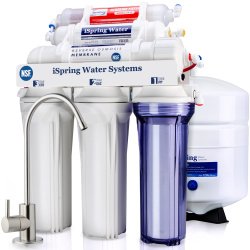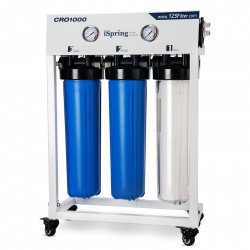
- How to know and understand the quality of your water
- Why Testing for TDS Alone is Ineffective
- Finding the ideal level of TDS
- iSpring’s reverse osmosis (RO) products
Understanding Your Water Filtration Needs
The majority of U.S. households use some form of water filtration for their drinking water, whether from their refrigerator, a water filtration pitcher, or an installed filtration system. However, many are unaware of what is being filtered out and whether it's actually necessary. One such thing is total dissolved solids (TDS).
As a universal solvent, water absorbs molecules. The number of dissolved particles in a volume of water that is not an H2O molecule comprises the TDS level.
Understanding your water’s TDS level and composition will provide you with the insight needed to know the quality of your drinking water as well as what kind of filtration would be most beneficial.
To identify your TDS levels, it is suggested you perform iSpring’s home water test.
However, to know your water’s composition, it is necessary to take a water sample to a testing facility. Only then will you have a clear picture of your water’s true quality and be able to determine which filtration system will best meet your needs.
Your Water Quality is Much More than Your TDS Level
High levels of TDS may indicate your water is not safe to drink, but this is not always the case. The dissolved solids in water are often a combination of healthy minerals.
However, if the high levels of TDS are because of hazardous minerals such as copper, iron, or lead, then you would want to use a water filtration system that can filter out those substances because they can be detrimental to your health.
For this reason, you cannot use your water’s levels of TDS as the only standard when examining your water quality. It is necessary to also know the composition and what your TDS levels are made up of.
Ideal Level of TDS
Because TDS does not equal dangerous drinking water, there is no true standard for a safe level of TDS in drinking water. NSDWRs (or secondary standards) are non-enforceable guidelines regulating contaminants that may cause cosmetic effects (such as skin or tooth discoloration) or aesthetic effects (such as taste, odor, or color) in drinking water.If the TDS level is too low, water will often taste flat.
Reverse osmosis(RO) system is the best option for lowering the TDS level. However, to improve the taste and enrich healthy elements in water, many customers with a reverse osmosis system frequently add an additional alkaline filtration stage to restore healthy minerals, creating better-tasting water.
Even some bottled water has different varieties such as purified water, mineral water, fluoridated water, etc. For mineral water, though the TDS is lowered during the filtration process, it still has no lower than 250 ppm of TDS according to the NSF.
iSpring’s Filtration Systems
At iSpring, we have a variety of filtration systems to meet customers’ unique needs. Some of our most popular are our reverse osmosis (RO) products. RO systems filter out more than 1,000 harmful contaminants and lower TDS. Through this process, however, many healthy minerals are removed as well. Because of the aforementioned flat taste this can create in water, we offer systems that utilize an additional filtration step to reintroduce these healthy minerals back into the water.
Two of these products are our RCC7AK and our RO500AK-BN. Through the RO process, both reduce the TDS and eliminate up to 99% of over 1,000 water contaminants as well as virtually all dissolved substances, including many harmful minerals, such as salt and lead, leaving you with pure, clean drinking water.
We also have commercial-grade products to provide small businesses with purified water while keeping up with their demand. One such product is our CRO1000. The CRO1000 uses a four-stage water filtration and features a space-saving tankless system. It is able to maintain on-demand clean, filtered water up to 1000 gallons per day.
Although other filters, such as ultrafiltration membrane, activated carbon filters, and, cannot reduce the TDS, they can remove other contaminants effectively. It is vital you understand your water’s unique composition and which filtration system would best meet your specific needs.
With this in mind, iSpring has developed a variety of filtration systems to meet your residential or small business needs, whatever they may be.



